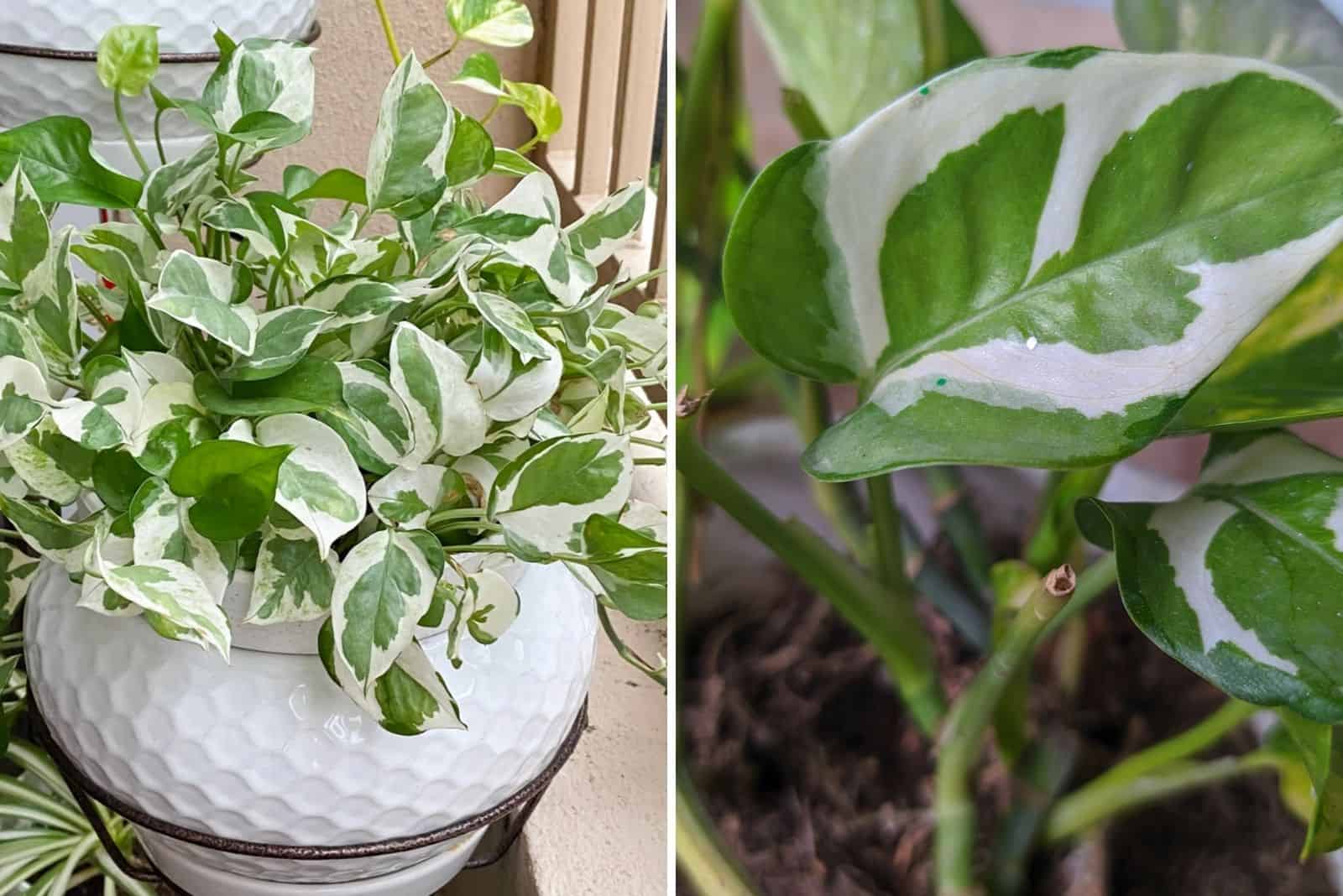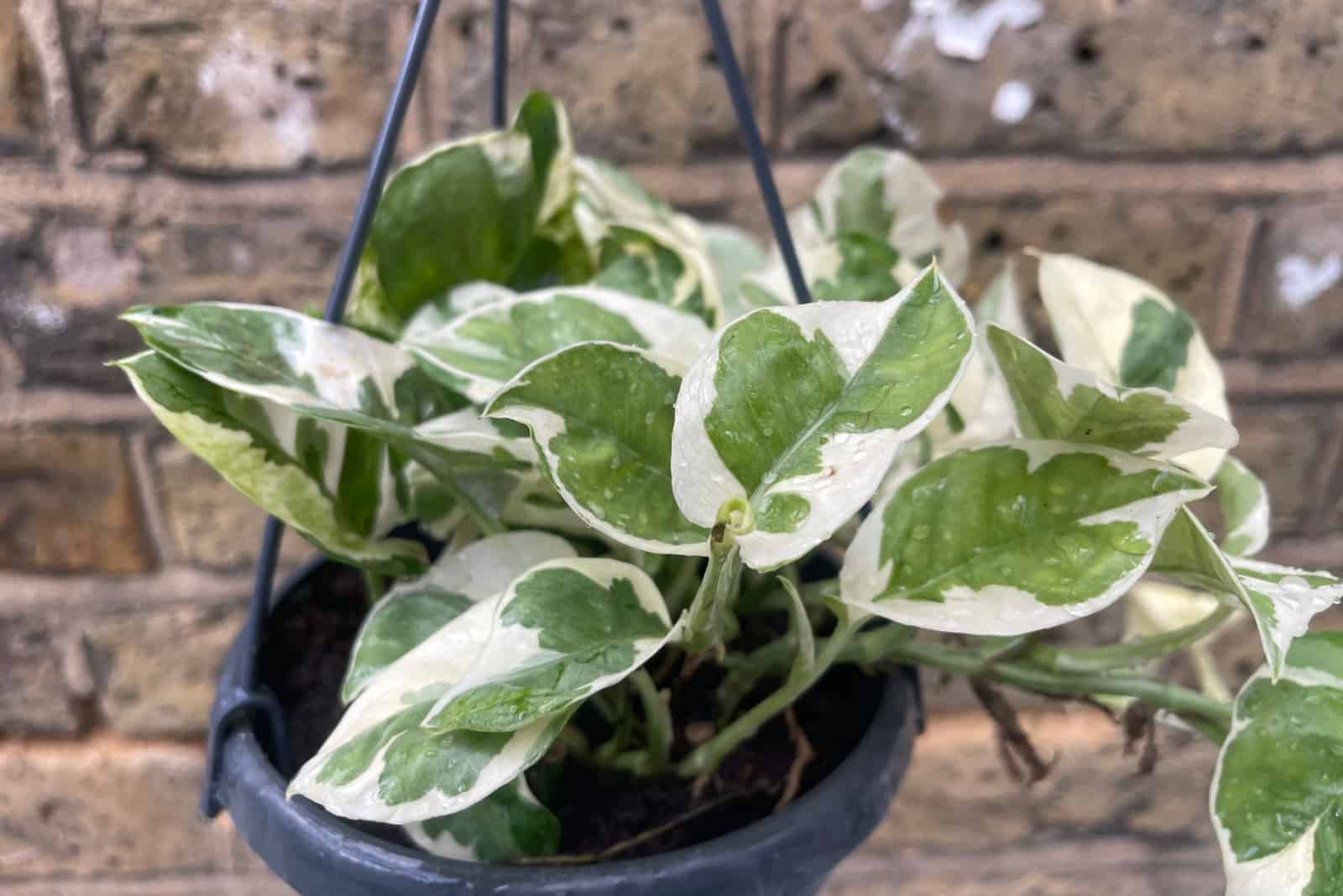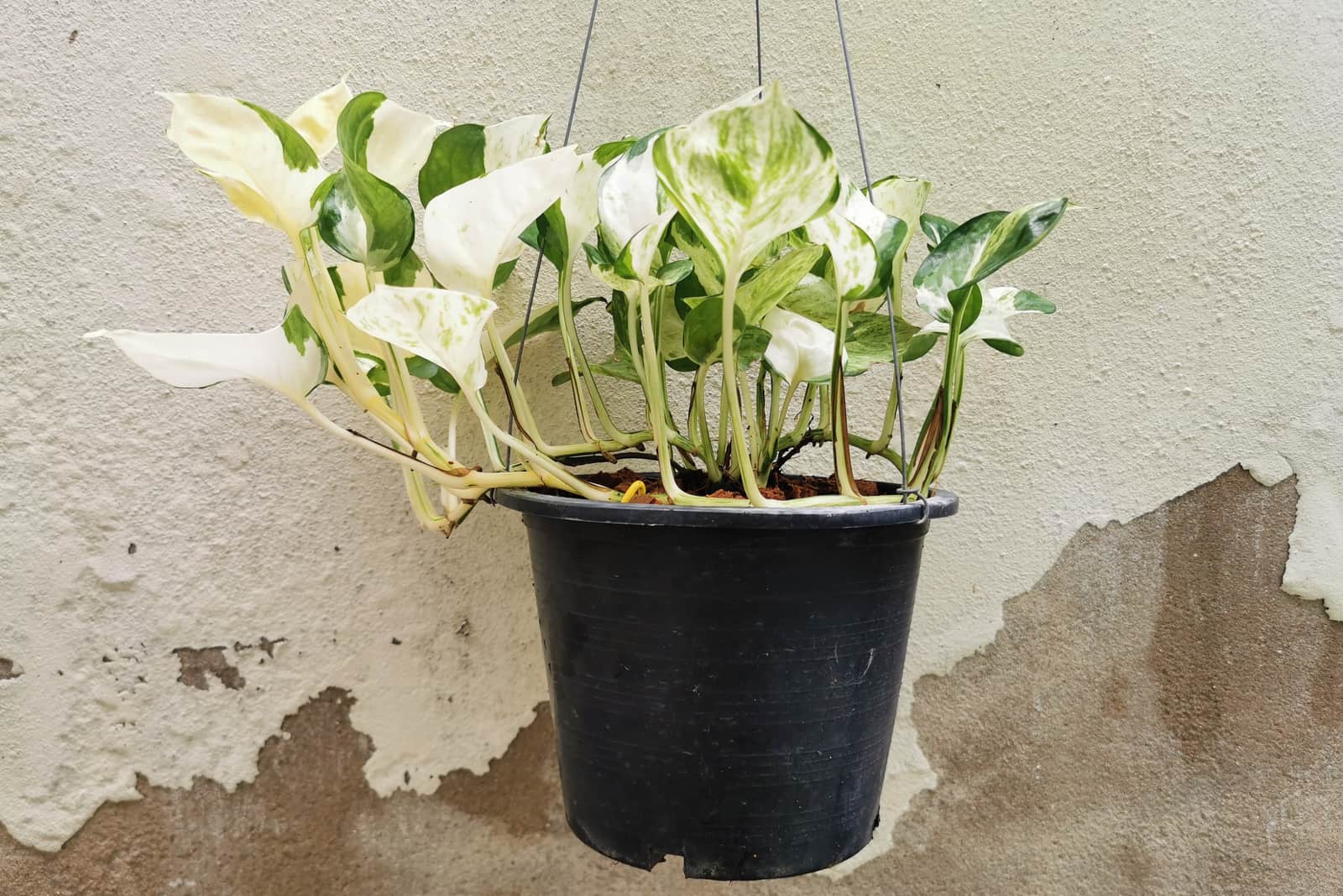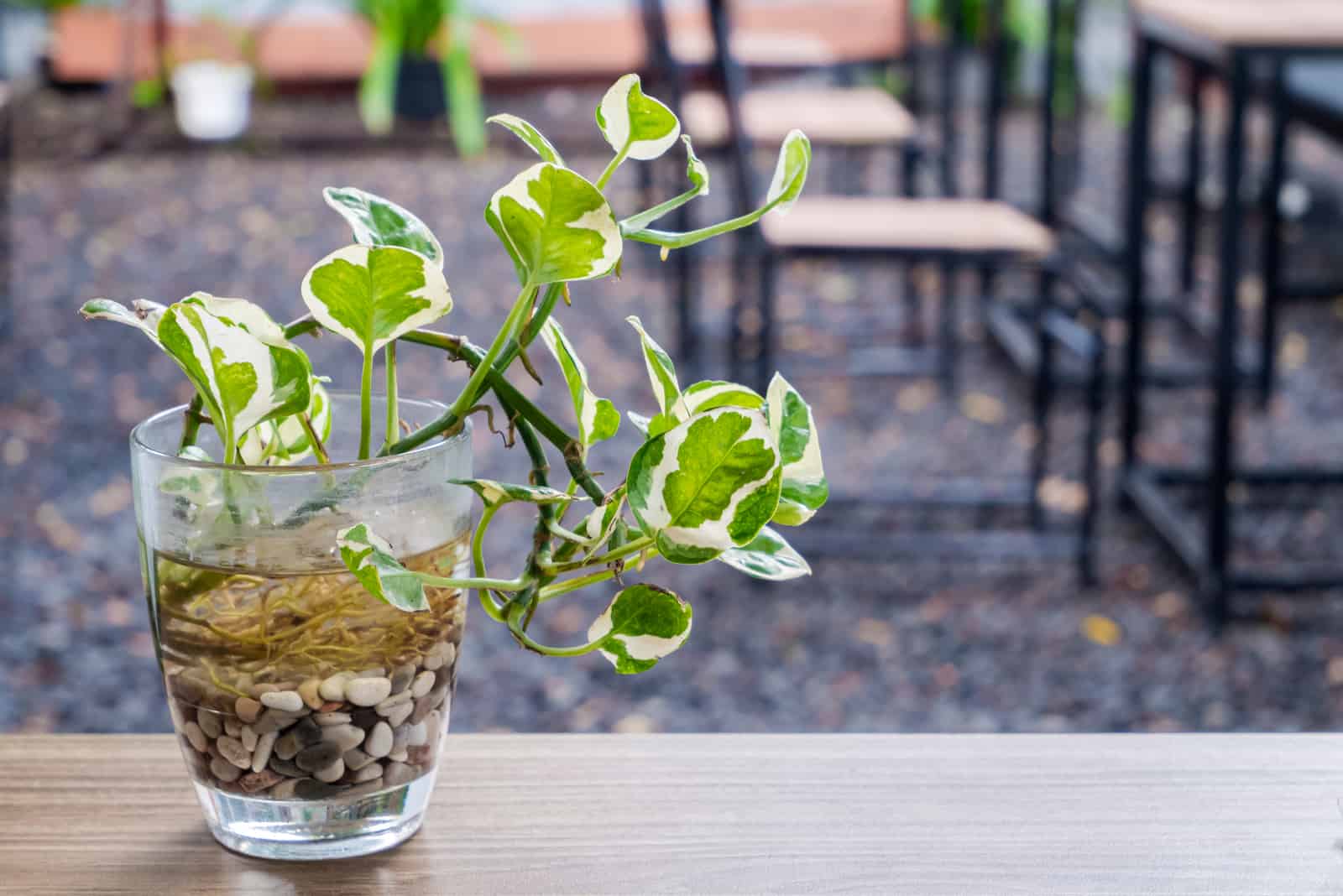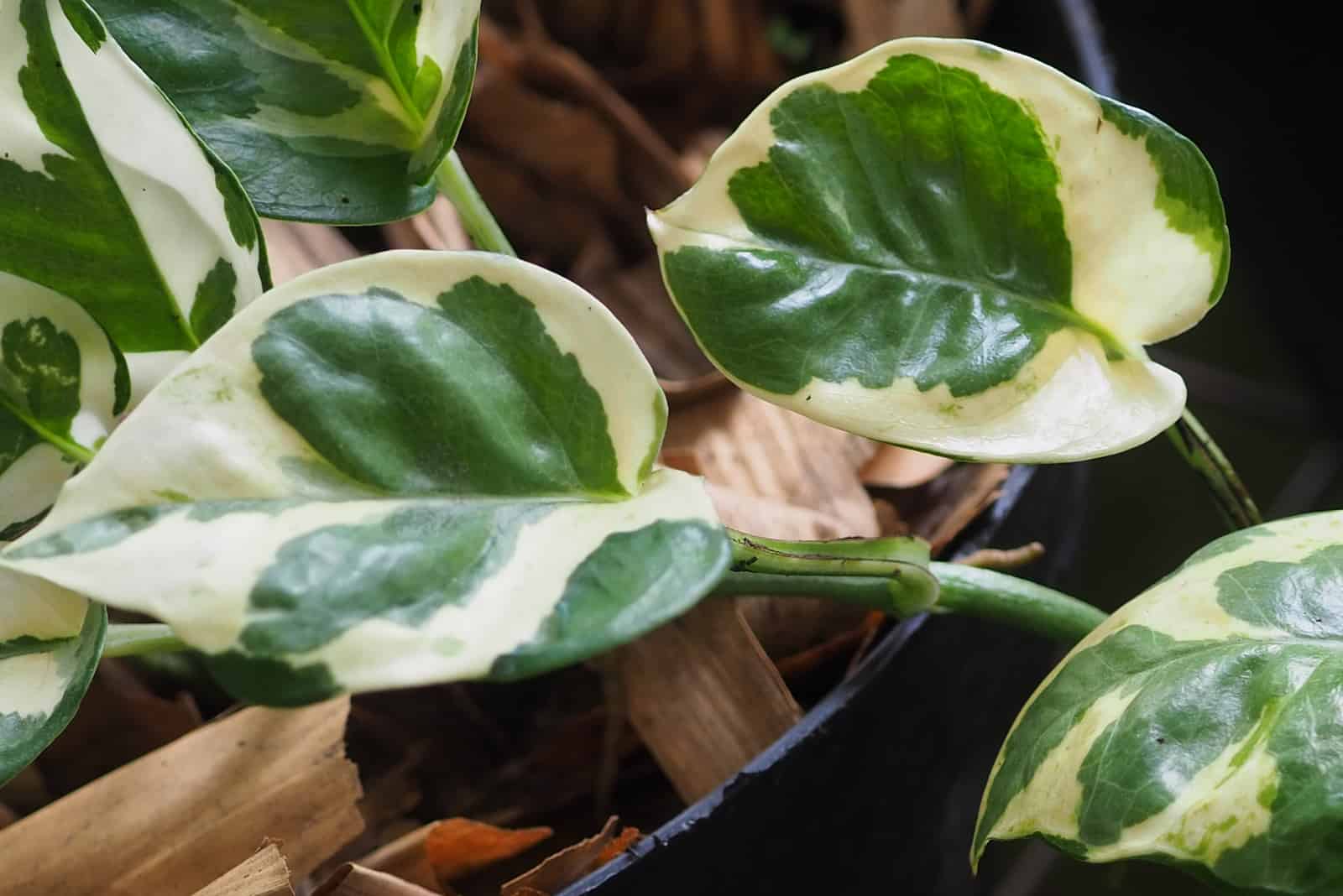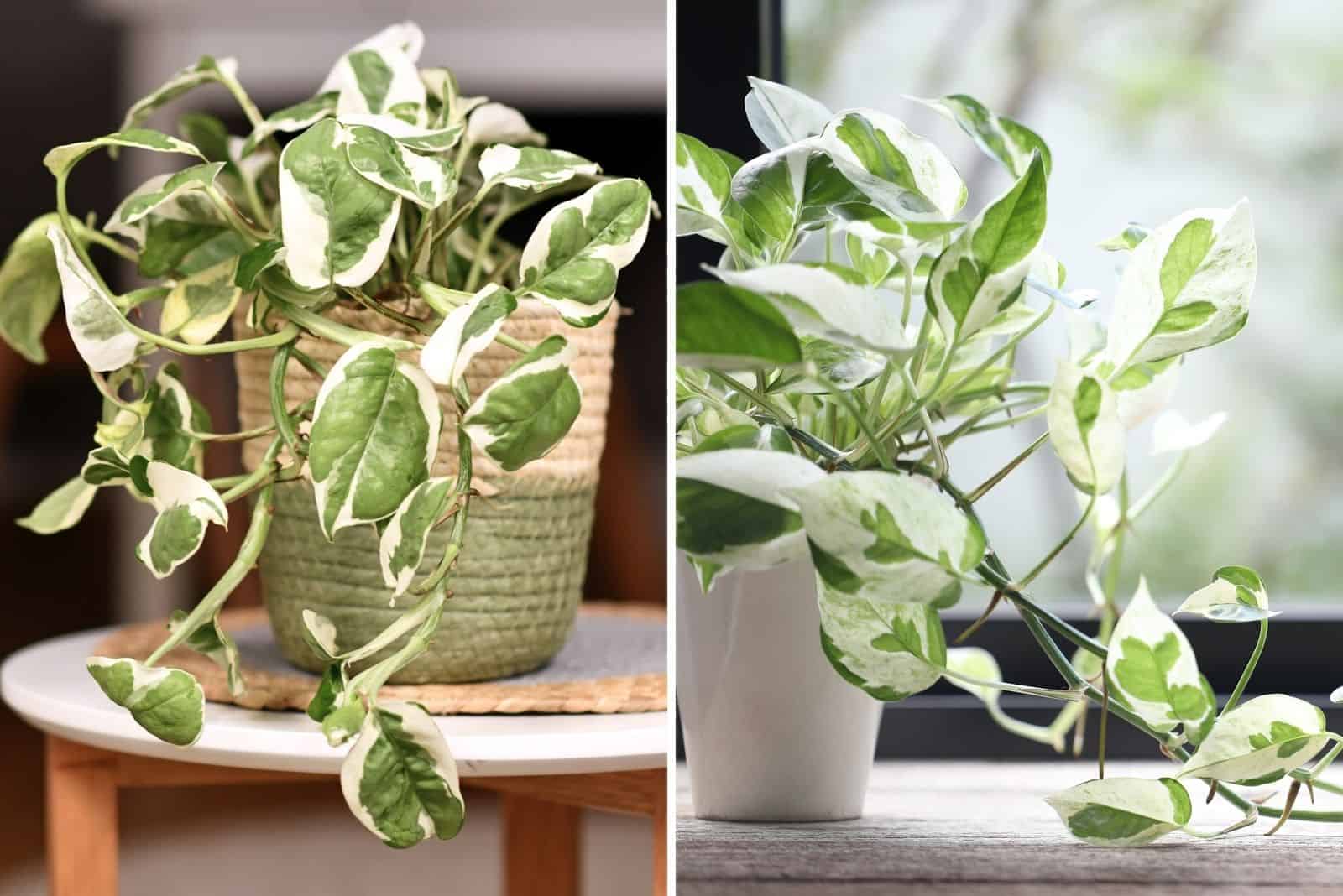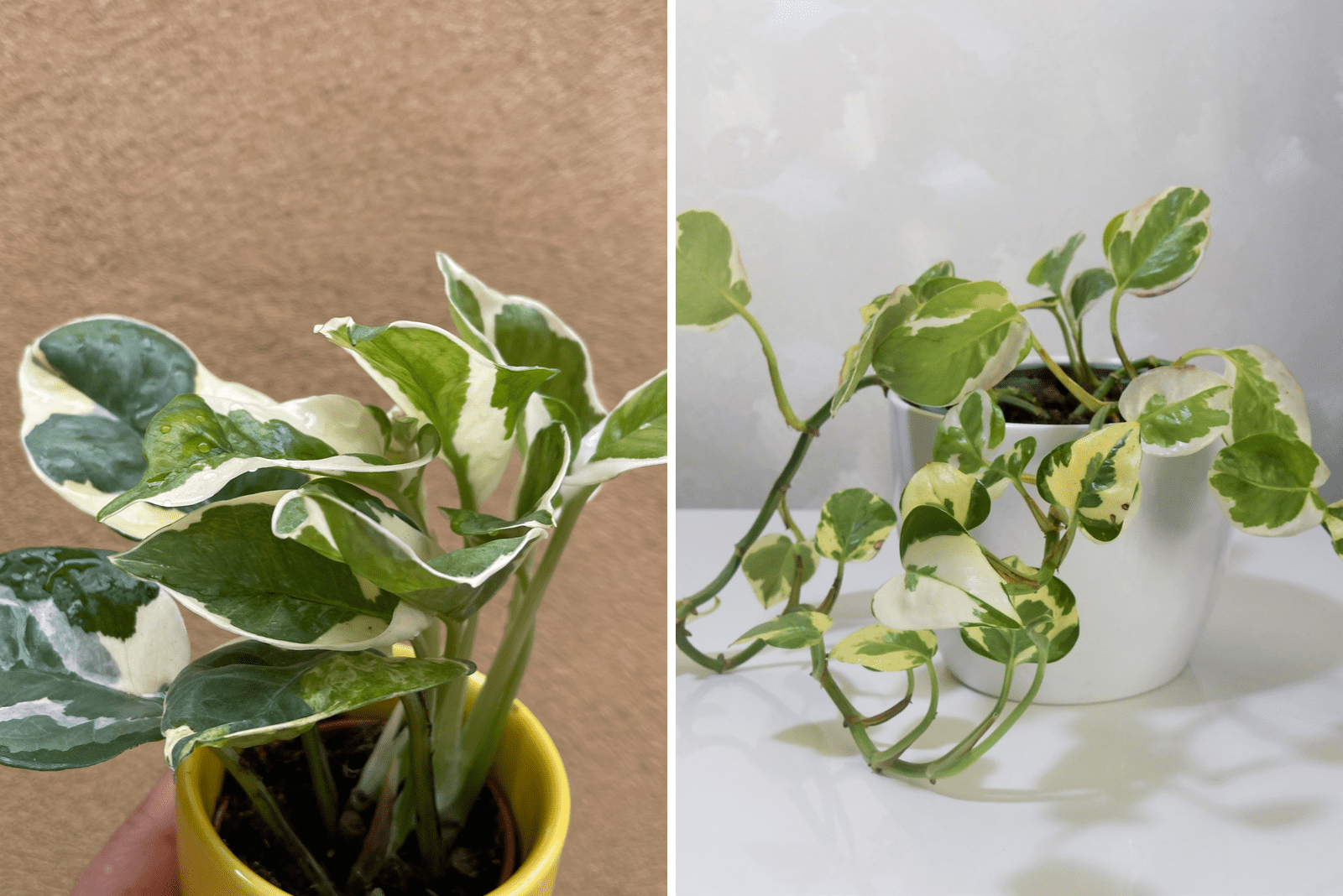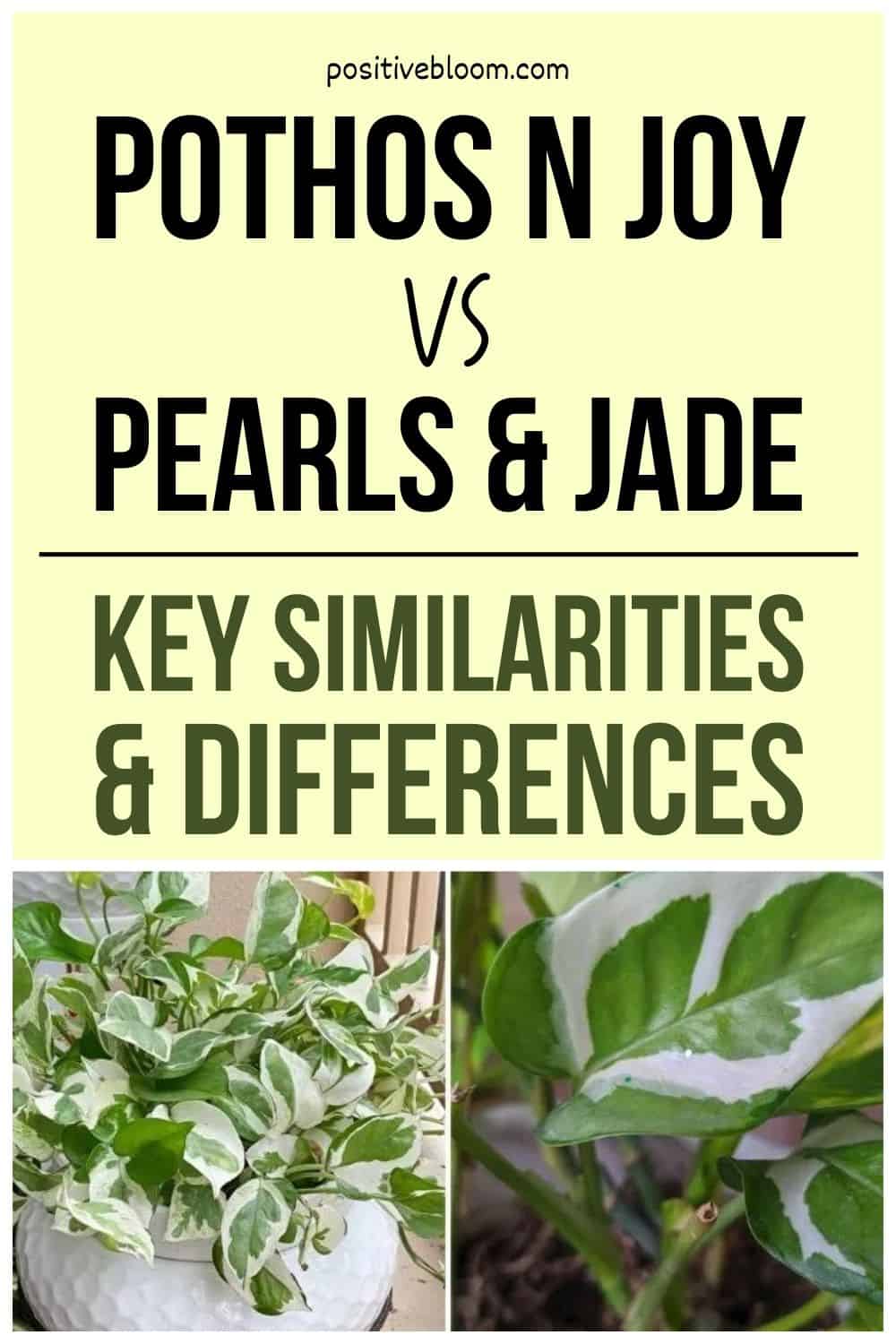Positive Bloom is an Amazon Associate and we earn from qualifying purchases through these links at no extra cost to you.
If you love variegated houseplants, then Pothos is perfect for you. This article brings you the main differences and similarities between Pothos N Joy vs Pearls and jade pothos.
Before we get into any detail, here’s the basic information about these plants:
[table id=79 /]
Both of these pothos varieties are toxic, but that doesn’t mean you won’t be able to find a way to work around this. Plant them in a gorgeous hanging basket, and you can enjoy this plant without worrying whether your pets will take a few of its attractive leaves.
This article brings you the basics of pothos care, so that you can grow some unique varieties that will be with you for many years to come.
Let’s begin!
Pothos N Joy vs Pearls And Jade Similarities
Pothos N Joy vs Pearls and jade have more in common than you might think. Sure, they slightly differ by the color and shape of their foliage, but there are so many more similarities to these plants than you know.
They are different cultivars of the same plant, Marble queen pothos have similar growing habits, and their requirements are virtually the same.
In the following section, you can read about all the connections between these two pothos varieties and decide which one will keep company with your own philodendrons and golden pothos.
Growth Habits
These pothos cultivars are easy to grow and have similar growth habits. Both are slow growers, making them perfect indoor plants as you don’t have to repot them very often.
Also, they belong to the genus Epinephr (devil’s ivy) for a reason: they are climbing or vining plants that can spread extensively.
However, when grown as houseplants, they usually don’t exceed the length of 1-2 feet (30-60 cm).
Both of these varieties are trailing, and knowing how to grow trailing pothos is important if you want them to be happy and healthy.
You can grow them in a hanging basket and leave them be, or you can stake them and grow tall pothos instead, so that your variegated Manjula pothos doesn’t get lonely.
They agree with everything; it’s just a matter of your preference!
Care Guide
Pothos plant care is straightforward, which is why they are the perfect plants for beginners. You only need to keep them hydrated, grow them in a well-draining medium, and not expose them to the direct midday sun.
However, it might be useful to know which kind of sunlight you should expose them to and how often you should water them.
That’s why we’re here, to help you grow healthy and lengthy pothos!
Light Requirements
These varieties of pothos require plenty of sunlight and keeping them in low light can not only stunt their growth but also make their leaves pale and insignificant.
Pothos do best in bright indirect light where they can get at least 6-8 hours of sunlight each day. Therefore, you might want to consider keeping them in rooms facing east, west, or south.
East-facing rooms are my favorite as you don’t have to worry about the direct sunlight hurting your plants. However, if you keep your N Joy or Pearls & jade in south- or west-facing rooms, you need to keep them at least 3 feet (90 cm) away from the windows.
Remember, low light conditions aren’t ideal for these types of pothos, but they also cannot survive in direct light.
Bright light is ideal, and if your room faces north, you can always use grow lights to keep your pothos happy.
Water Requirements
Pothos ‘N Joy’ and ‘Pearls and jade’ are tropical plants that need moisture to survive. However, we always tend to overwater these poor creatures, precisely because of the word “tropical.”
Tropical doesn’t mean they love sitting in water all day, but rather that they need moist soil to survive.
The best watering technique is to wait until the topsoil is dry before you water the plant. Irrigate the plant with a generous amount of water, letting it drain through the drainage holes.
Also, these pothos varieties enter dormancy in winter, and they don’t use much water when they are asleep. You should water them less and let the soil dry almost completely between waterings.
Climate And Temperature
Pothoses love the tropical climate, which means they love warm temperatures and high humidity levels.
You can raise the humidity by misting the foliage every now and then or by investing in a small humidifier that will do the work for you. However, we prefer the pebble tray method, which does the job just as well, and also adds that special something to your home decor.
The pothos’ preferred temperature is between 65-85 °F (18-29 °C), but as long as it isn’t below 50 °F (10 °C), your plants should be just fine.
However, you should avoid any sudden changes in temperature and don’t keep your plants below the AC, this will only cause damage to your pothos.
Soil And Fertilizer
These pothoses like mildly acidic mediums with a pH level between 6.1 and 6.5, and they need fertile, well-draining soil, so if you forgot to get an aroid potting mix, you could always create your own.
Add plenty of perlite for drainage and peat moss for moisture retention, to your favorite potting soil, and you’ll have a suitable medium for planting pothos. You can also add coir for more drainage and orchid bark to improve aeration, and your plants won’t be able to tell the difference between the homemade and the store-bought substrate.
Fertilizer
N Joy and the pearls are light feeders, so they don’t need lots of fertilizer. However, if they have used all the nutrients from the soil, you should fertilize them once a month or every two months so they can get all the nutrients they need.
You should use well-balanced liquid fertilizer, preferably orchid or aroid, to reduce the risk of fertilizer burn.
Don’t feed your plants during dormancy! They cannot use the food you give them, and you’ll only end up with fertilizer salt build-up and over-fertilized plants with burns all over their foliage.
Propagation
The easiest method of propagating these plants is through stem cuttings, and thankfully, you can multiply your pothos this way and grow many companions for your neon pothos.
All you need to do is choose a healthy stem with many leaves and cut it just above the leaf node. Afterwards, you need to decide whether you want to propagate it in water or soil.
Propagation In Water
If you propagate the stem in water, you need to put it in a jar or some other vessel filled with water and remove all the leaves that are fully submerged in water, as they will decay and contaminate the water.
After some time, you will notice the development of the root system, which is your cue to plant them in a container or a pot filled with fresh potting mix.
Propagation In Soil
Propagating stem cuttings in soil takes longer than in water but is effective just the same. Take the healthy cutting and put it in a moist, well-draining medium.
You can use root hormone for faster growth if you like, but if you don’t have it, don’t worry; your plant will propagate without it.
Here are some guidelines for propagating pothos plants in both mediums so you can pick one you prefer.
Cleaning And Pruning
We prune plants for various reasons, some of which are to stop diseases from spreading, to control the space and growth of the plant, and to remove the dead or dying foliage.
Pothos are low-maintenance plants, but they still require pruning from time to time.
When you want to control the growth of pothos, you should never prune more than one-third of the entire plant, so as not to stunt its growth.
Removing dead or dying leaves is done to make your plant look better and save the energy it spends on already dying foliage.
Lastly, you should cut off the infected foliage as soon as you notice something is not right with your plant so as to stop any disease from spreading.
Also, since these varieties of pothos have large foliage, you should clean them once in a while so they are not dust-collectors. Use a wipe cloth to do so, and allow the foliage to dry before the next wiping, as you don’t want it to catch a disease like leaf spot.
Common Issues
Indoor plants often suffer from pests or diseases like root rot and powdery mildew. So, if you want to know how to deal with and prevent these issues, stick around for a moment or two.
This section brings you the most common issues that you may encounter if you have any kind of pothos and how to react when times get tough.
Also, one of the things we hate seeing is curled pothos leaves, and there are many reasons for that, but the most common ones include pest infestation and some infections.
Pests
You may not like it, but pests are an unavoidable aspect of growing plants. But, if you know how to treat infested plants properly, they will no longer pose an issue.
The most common pests that attack pothos are spider mites, mealybugs, whiteflies, and thrips.
You should get rid of them as soon as you notice they have inhabited your plant. Use a strong spray of water to remove a larger group, or dip a cotton pad or Q-tip in rubbing alcohol and remove them one by one. Just be careful not to touch your plant because alcohol can burn it.
If you don’t believe in these methods, you can always use insecticidal soaps and horticultural oils to remove the nuisances.
Diseases
The most common disease that affects pothoses is root rot. You can avoid it by simply not overwatering your plant.
However, if you notice wilting and yellowing of the foliage, stunted growth, and fungus on the topsoil, you should immediately check the plant’s roots.
If they are brown or black and soft and mushy, your plant is infected with root rot, and you should remove the diseased parts at once. After removing the infected roots, replant the pothos, and don’t overwater it.
Another common disease is leaf spot, which can develop if you leave the leaves wet for long periods of time. As soon as you notice yellow circles on the leaves, isolate the pothos so that the infection doesn’t spread onto other plants and remove the diseased foliage.
Afterwards, you can spray the foliage with fungicide and hope for the best.
Pothos N Joy vs Pearls And Jade
Even though Pothos N Joy vs Pearls and jade have many similarities, certain things differentiate them and help us to determine which is which.
They don’t come from the same background, and their foliage looks completely different if you know what to look for.
Even though they are both vining plants, they don’t grow branches in the same way, and they don’t respond in the same way to poor conditions.
History
Both N Joy and the Pearls and jade are cultivars of the Marble Queen pothos. However, they did not develop and originate in the same manner.
Pothos ‘N Joy’ resulted from a natural mutation and was discovered in 2002 by Ashish Arvind Hansoti. The researchers monitored this mutated plant and, after almost two decades, it is now a stable mutation that decorates thousands of homes.
It has many different names: Devils Ivy ‘N Joy’, Scindapsus aureum ‘N Joy,’ and Philodendron ‘N Joy.’
On the other hand, the Pearls and jade pothos was created in a laboratory by the University of Florida and is often referred to as a money plant.
Foliage
The main parts by which we differentiate between the N Joy and the Pearls and jade are their variegated leaves.
It is not only the variegations that vary but also the shape, size, and texture of the foliage.
This next section brings you the main features of the foliage of both these two varieties.
Color
A young N Joy has green variegation, but as it grows older, white parts start to appear until the white variegation takes over, and the green color appears only sporadically.
However, this pothos requires high levels of sunlight in order to keep its coloration. If you doom it to life in shade, its white parts will turn yellow-green with sparse dark green details.
The white and green streaks chaotically intertwine, but there is a sense of order in that chaos too.
The Pearls & Jade is also striped, with long white and green lines, but the lines between them are not clear. There are blotches of green on the white parts that aren’t truly white; rather, they are cream or even pale yellow at times.
The green leaf parts are not dark; they’re more of a bright or light green color.
Shape And Size
The Pearls and jade pothos has more elongated leaves than the N Joy, and the petiole that connects the leaf to the stem is incised in such a way that, together with the pointed tip, it makes the leaf heart-shaped.
On the other hand, N Joy’s leaves are oblong with sharper tips.
The N Joy has smaller leaves, about 2 inches (5 cm) long and almost 1.5 inches (4 cm) wide. The foliage of the Pearls and jade is longer, around 3 inches (7.5 cm), but not wider.
However, even though the leaf shapes and leaf sizes differ to some extent, both varieties will make a great addition to your indoor garden.
Texture
The top and the bottom side of the N Joy leaves are different. The top is smooth and shiny – we could even say waxy, whereas the bottom has a leathery texture.
The texture of the Pearls and jade foliage is consistent throughout the entire leaf, and it feels as if you’re holding a piece of paper between your fingers.
Preferred Conditions
Both plants have precisely the same needs for water and light, but if those conditions aren’t met, they will react differently.
Pothos n joy is more resilient to light inconsistencies, and it can handle direct sunlight better than a Pearls and jade, which gets sunburns easily.
However, the Pearls and jade is more drought-tolerant than the N Joy, so you can even forget to water it sometimes, and it won’t affect its beautiful coloration. Also, the N Joy is more susceptible to overwatering, so you’ll have to pay close attention to that as well.
Structure
The first thing we notice in the structure of the N Joy is that it branches from the center, as if in small clusters.
Lateral branches are about four inches (10 cm) long and usually grow ten leaves.
The Pearls and Jade has longer internodes (spaces between two leaf nodes).
Which Plant To Choose, Pothos N Joy Or Pearls And Jade
Finally, we get to the point where we need to decide which pothos to select for our home decor, the Pothos N Joy or the Pearls and jade.
There are a few things that can help us to pick the pothos that suits us best, such as its resilience to water and light, its color, and the appearance of its foliage.
I would recommend getting the Pearls & Jade if you’re a beginner gardener as it is more drought-tolerant and less susceptible to overwatering than the N Joy.
However, if you live in a south-facing flat, you might want to consider getting an N Joy as it is more resilient to direct sunlight.
It is also a matter of preference; the Pearls and jade often has blotches of green on white variegations, whereas the N Joy doesn’t. And, I don’t know about you, but heart-shaped leaves light up every corner of my living room, and now I can’t remember how I could have ever lived without my Pearls & Jade pothos.
Lastly, they’re both low-maintenance plants, and you won’t be wrong in choosing either one!
Thankfully, this package includes two hanging planters, so you don’t have to decide which pothos to get.
[lasso id=”2814″ link_id=”2133″ ref=”amzn-mkono-boho-hanging-planter-set-of-2-metal-plant-hanger-with-plastic-pots-modern-mid-century-flower-pot-plant-holder-in-diamond-and-circle-shape-fits-6-inch-planter-plastic-pots-included-gold”]
To Sum Up
This article has compared two exceptional pothos cultivars, and now you know how to differentiate between Pothos N Joy vs Pearls and jade with ease.
There are many similarities, and thankfully, one of them is their care guide. This means that you can get both varieties at the same time, and it won’t feel like a bother as you don’t have to remember two preferred watering techniques, types of soil and fertilizer, and so on.
They are easy to maintain, meaning that they are suitable for everyone. And once you see their variegations brightening your homes, you will instantly fall in love with both varieties.
However, if, for some reason, you can’t grow two varieties at once, we have told you which one we prefer.
Enjoy and until next time!
Like this post? Share or pin it for later!

